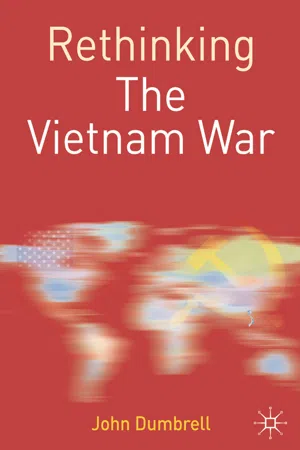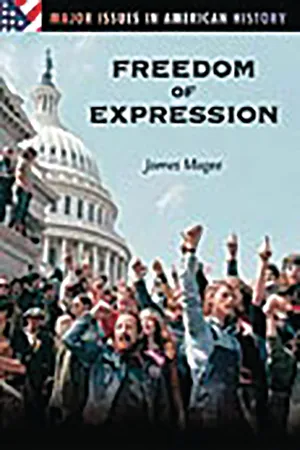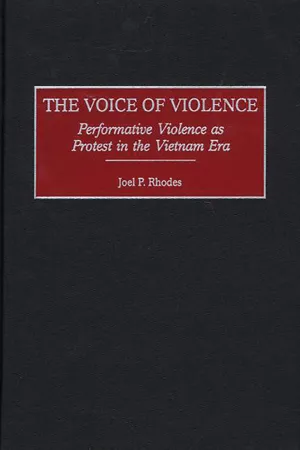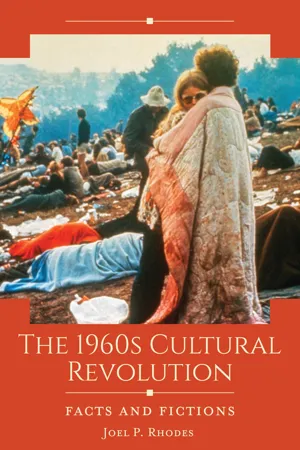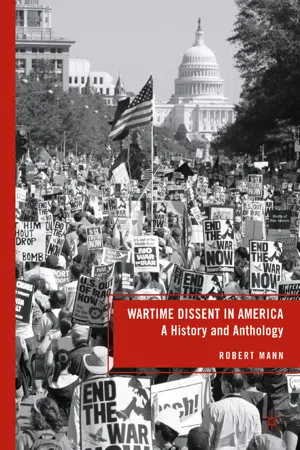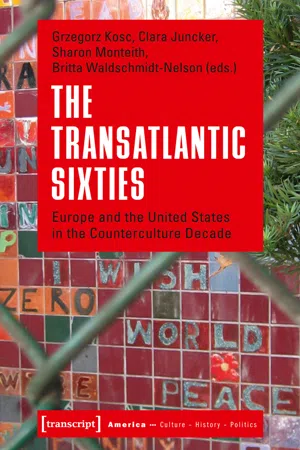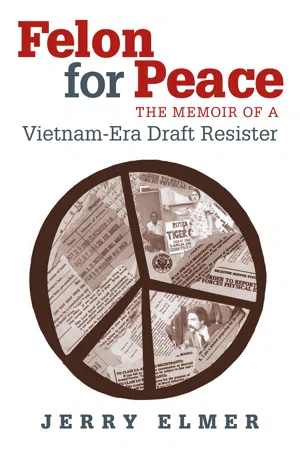History
Vietnam War Protests
The Vietnam War protests were a series of anti-war movements and demonstrations that took place in the United States during the 1960s and 1970s. They were fueled by opposition to the U.S. involvement in the Vietnam War and drew participation from a diverse range of groups, including students, civil rights activists, and religious organizations. These protests played a significant role in shaping public opinion and ultimately influencing government policy regarding the war.
Written by Perlego with AI-assistance
Related key terms
1 of 5
11 Key excerpts on "Vietnam War Protests"
- eBook - PDF
Vietnam War Era
People and Perspectives
- Mitchell K. Hall(Author)
- 2009(Publication Date)
- ABC-CLIO(Publisher)
Such responses indicate not just patriotism but also a hope that conformity will bring acceptance and a breakthrough in terms of social and political status. This breakthrough syndrome operated powerfully in creating support for the Vietnam War. Yet the American people ultimately turned against their nation’s involvement in the Vietnam War. In one of the great social movements of modern times, antiwar protesters led the way. There is some debate about the consequences of protest. Because the image of the typical protester was that of a long-haired student with scant respect for the law or conventional morality, public opinion tended to be hostile to protest even as it turned against the war, so the White House was able to use protest as a justification for continuing the war. Some argue that protest was counterproductive and prolonged, even as it doomed, the war. According to another school of thought, Hanoi and its communist allies in South Vietnam took courage from the antiwar movement and fought longer and harder as a result. However, finally and much more convincingly, there is the argument that the policy makers listened. Just as the Republican president William McKinley had abandoned his imperialist agenda to under- mine the appeal of the Democrats in the election of 1900, so President Richard Nixon withdrew from Vietnam to hang on to political office. When Joan Baez sang in New York’s Central Park to celebrate the war’s end, she and her supporters believed they were also rejoicing in their own victory as protesters. So did the neoconservatives who saw America’s withdrawal as mistaken, premature, and tragic, the action of pusillanimous politicians who bent the knee to unpatriotic protesters. To the theory that protest forced American withdrawal from the war, there is a bipartisan ring of truth. One could explain with deceptive ease why protest occurred and how it succeeded. - eBook - PDF
- John Dumbrell(Author)
- 2012(Publication Date)
- Red Globe Press(Publisher)
Antiwar protest also demonstrated to ‘the Vietnamese and Third World people that an aggressive war will be met with broad resistance inside America’ (Hayden 2008: 115). The notion of the antiwar movement as a credible and potent agent of precipitate American withdrawal from Vietnam has found its way into many accounts of the conflict. In various forms, approving and disapproving, this view of the antiwar movement informs both orthodox and revisionist interpretations of the war. George Christian, White House aide in the later 1960s, felt that Lyndon Johnson’s ‘inability to move about the country freely with-out having demonstrations’ definitely did affect Vietnam policy, and contributed to LBJ’s 31 March 1968 turnaround. Tom Wells specifically enumerated instances where protest activity appeared to have a clear impact on war-related decisions, such as LBJ’s determination in 1965 not to call up American reserve forces. Plans for a 1971 antiwar movement ‘spring offensive’ were seen by Wells as influencing President Nixon’s decision to announce the with-drawal of 100,000 troops on 7 April. Wells quoted Sidney Peck, a protest organizer, as concluding that the ‘offensive’ had succeeded also in having ‘really a major impact on Congress’(Wells 1994: 37, 105, 153, 513). 148 Rethinking the Vietnam War Assessments of the impact of the antiwar movement on actual policy are often couched in terms which recognize the counter-productive effect of movement excesses. George McGovern (1992: xii), for example, later saw public opposition to movement extremism as contributing to his own electoral defeat in 1972. Yet, George McGovern felt in 1992 that the movement had set the stage for America’s exit from Vietnam. Even for Tom Wells (1994: 6), the movement’s impact was damaged by ‘internal strife’, as well as the ‘unrealistic expectations and political impatience of many activists’. - eBook - PDF
- James Magee(Author)
- 2002(Publication Date)
- Greenwood(Publisher)
Many others confronted the political establishment, through street demonstrations and protests on college campuses. The momentum of both the antiwar and civil rights movements unleashed frustrations of other disgruntled groups, such as 202 Freedom of Expression women and gays who also publicly challenged their official second-class citizenship. Average American citizens still accustomed to the calm rou- tine of life depicted on 1950s television, exemplified by the all-American families in Ozzie and Harriet and Leave It to Beaver, were in the late 19 bombarded by culture shock. The parallels between antiwar activism and civil rights protests were unmistakable. Both in the beginning of their campaigns did not have the national media or prominent media personalities on their sides, but their messages were eventually picked up and endorsed by the national press. Also, both protesting groups were essentially politically powerless: The Constitution gave blacks the right to vote, but it was eclipsed by the same kind of laws and practices that civil rights activists were trying to eradicate; young men of draft age could not vote until they were twenty- one. Thus demonstrations and other forms of protest provided the most readily available means of sending their political messages. The efficacy of sits-ins and other forms of earlier symbolic opposition taught antiwar activists how to convey and publicize their messages. People debated the war everywhere else—in classes, in journals and editorials, at parties and picnics, and around the dinner table. But the press always prefers to cover "disturbances," and antiwar protests disturbed the country. College students became the driving force of the antiwar movement because young male students were directly affected. Even before the Vi- etnam War climbed to the top of the national agenda, a student political movement had already been underway. - eBook - ePub
- Immanuel Ness(Author)
- 2015(Publication Date)
- Routledge(Publisher)
Ultimately, however, the antiwar movement left a profoundly indelible impact on America. It changed Vietnam policy, limiting America's options and military involvement in Southeast Asia, as movement chroniclers Tom Wells, Melvin Small, Thomas Powers, and others have demonstrated. It introduced new forms of dissent into the arena of America democracy. An alliance of many different groups emerged and challenged the U.S. war effort in Vietnam, with a scope and tenacity unprecedented in the history of American social protest movements. It ushered in an epic struggle over what sort of nation the United States ought to be, and it inspired other protest efforts in the process. In the end, the efforts of countless antiwar activists—in thousands of different communities across the United States—diminished American militarism, while at the same time greatly enhanced the nation's democratic traditions.Andrew HuntBibliography
Anderson, Terry. The Movement and the Sixties: Protest in America from Greensboro to Wounded Knee . New York: Oxford University Press, 1994.DeBenedetti, Charles, with Charles Chatfield. An American Ordeal: The Antiwar Movement of the Vietnam Era . Syracuse, NY: Syracuse University Press, 1990.Dellinger, Dave. More Power Than We Know: The People's Movement Toward Democracy . Garden City, NY: Anchor/Doubleday, 1975.Flacks, Richard, and Jack Whalen. Beyond the Barricades: The Sixties Generation Grows Up . Philadelphia: Temple University Press, 1989.Foley, Michael S. Confronting the War Machine: Draft Resistance During the Vietnam War . Chapel Hill, NC: University of North Carolina Press, 2003.Hall, Mitchell K. Because of Their Faith: CALCAV and Religious Opposition to the Vietnam War . New York: Columbia University Press, 1990.Halstead, Fred. Out Now! A Participant's Account of the American Movement Against the Vietnam War . New York: Monad, 1978.Hunt, Andrew. The Turning: A History of Vietnam Veterans Against the War . New York: New York University Press, 1999.Powers, Thomas. Vietnam: The War at Home - eBook - PDF
The Voice of Violence
Performative Violence as Protest in the Vietnam Era
- Joel P. Rhodes(Author)
- 2001(Publication Date)
- Praeger(Publisher)
Chapter 1 Introduction Maybe we just have to admit that the day of violence is here, and maybe we havetojust give up and let violence take its course. The nation won't listen to our voice - maybe it'll heed the voice of violence. - Martin Luther King, Jr. March 1968 One of the hallmarks of the late 1960s is conflict: between war and peace, national interests and individual rights, social justice and racism, young and old, straight and freak, custodial liberalism and participatory democracy, us and them. Across the nation, a general rejection of the existing systems of authority and disobedience to previously respected "superiors" in all their forms spread like wildfire in the Vietnam era, dividing the nation as it had not been since the 1860s. As the nation grew increasingly polarized on these and other issues, many social activists who chose to take a stand on the Left staged an "endless pageant of political and cultural protest" as a means of communication with the dominant institutions of American postwar society. Those who enlisted in this battle, within what is loosely referred to as "the movement" sought to resolve the era's conflicts with productions of public protest, specifically produced to debate, persuade, and ultimately educate the nation. 1 These symbolic actions took many forms: petitioning, rock throwing, canvassing, letter writing, vigils, sit-ins, freedom rides, lobbying, arson, draft resistance, desertion, fragging, assault, hair growing, nonviolent civil disobedience, operating a free store, rioting, confrontations with cops, consciousness raising, screaming obscenities, singing, hurling shit, marching, raising a clinched fist, bodily assault, tax refusal, guerrilla theater, campaigning, looting, sniping, living theater, rallies, smoking pot, destroying draft records, blowing up ROTC buildings, court trials, murder, immolation, strikes, and writing various manifestoes or platforms. - eBook - PDF
The 1960s Cultural Revolution
Facts and Fictions
- Joel P. Rhodes(Author)
- 2022(Publication Date)
- ABC-CLIO(Publisher)
DeBenedetti with Garfield underscored the damage done to peace activist’s believability and effectiveness by the movement’s bad reputation. “The alignment of antiwar activism with other social and cultural change likely reinforced a popular impression that protest itself was a social prob- lem. Therefore the antiwar movement and the war were resented for the T H E 1 9 6 0 S C U L T U R A L R E V O L U T I O N 212 same reason: they were eroding familiar values and institutions” (DeBene- detti with Garfield 1990, 403). Political scientist John Mueller also explored the depth of middle America’s disdain for anti-war activism. In this selection from his essay in Peter Braestrup’s anthology Vietnam as History, Mueller focused on reac- tion to the violent demonstrations surrounding the Democratic National Convention in the summer of 1968: [T]he Vietnam protest movement generated negative feelings among the American public to an all but unprecedented degree. In a poll conducted by the University of Michigan in 1968, the public was asked to place var- ious groups and personalities on a 100-point scale. Fully one-third of the respondents gave Vietnam War protesters a zero, the lowest possible rating, while only 16 percent put them anywhere in the upper half of the scale. Other studies suggest that popular reaction to the disturbances surround- ing the Democratic convention of 1968 was overwhelmingly favorable to the Chicago police and unfavorable to the demonstrators, despite press coverage that was heavily biased in the demonstrators’ favor. Opposition to the war came to be associated with violent disruption, stink bombs, desecration of the flag, profanity, and contempt for American values. Not only would these associations tend to affect public opinion in a negative way, they also would tend to frighten away more “respectable” would-be opponents from joining the cause. - eBook - PDF
Wartime Dissent in America
A History and Anthology
- R. Mann(Author)
- 2016(Publication Date)
- Palgrave Macmillan(Publisher)
role. That month, U.S. war planes began a three-year bombing campaign—named Rolling Thunder—over North Vietnam. In March 1965, the first wave of U.S. combat troops landed on the beaches at Da Nang. Before the year’s end, eighty thousand American troops would be in Vietnam. Back home, an antiwar movement was born. At first, it was peaceful. In March 1964, three thousand students and faculty members at a handful of universities turned out for a series of lectures and debates about the war known as “teach-ins.” The idea quickly spread. Students and faculty members held teach-ins on thirty- five college campuses the following week. Before the summer break, more than 120 colleges across the nation had begun their own teach-in protests, including a six-hour event at the University of California at Berkeley in May, attended by more than twenty thousand people. Another teach-in that month, in Washington, DC, reached more than one hundred thousand people on 122 campuses via a closed- circuit radio network. 4 The Vietnam War 129 Students and others were also hitting the streets in protest. In April, more than fifteen thousand protesters gathered in Washington, DC, many more than the organizers—Students for a Democratic Society (SDS)—had expected and the largest gathering of war protesters assembled in U.S. history. The protesters picketed the White House, three and four abreast, before adjourning to a theater near the Washington Monument to hear speeches by Senator Gruening, journalist I. F. Stone, civil rights leader Robert Moses, and Paul Potter, the twenty-two-year- old SDS president. 5 In Congress and at the White House, some officials viewed the nascent protest movement with alarm. - eBook - PDF
The Transatlantic Sixties
Europe and the United States in the Counterculture Decade
- Grzegorz Kosc, Clara Juncker, Sharon Monteith, Britta Waldschmidt-Nelson, Grzegorz Kosc, Clara Juncker, Sharon Monteith, Britta Waldschmidt-Nelson(Authors)
- 2014(Publication Date)
- transcript Verlag(Publisher)
In fact, the civil rights movement for equal rights, primarily of African Americans, and the anti-war movement were closely intertwined. They shared the appeal to justice, the impatience with the status quo, the grass roots ideals and many forms of protest. Many who were apolitical but restless felt attracted to both. Michael Herr con-cludes his important book about the Vietnam War, Dispatches (1977), with a melancholic variant of this perception: “Out on the street I couldn’t tell the Vietnam veterans from the rock and roll veterans. The Sixties had made so many casualties, its war and its music had run power off the same cir-cuits for so long they didn’t even have to fuse. . . . What I’d thought of as two obsessions were really only one, I don’t know how to tell you how complicated that made my life.” 7 Because African Americans provided a disproportionately large number of the soldiers, and victims, on the battle-fields, they quickly perceived that injustice and racism at home were mir-rored in South East Asia. The documentary film No Vietnamese Ever Called Me a Nigger (1968) announces already in its title this fusion of do-mestic and overseas experience and protest. During interviews along the protest march through Harlem on April 15, 1967, black bystanders and war resisters explain in various ways their understanding of how the global sys-tem works, in Vietnam and at home. A radical perspective was represented in the documentaries which the Newsreel Collective produced about anti-war as well as civil rights protest. Starting in 1967, the Newsreel Collective assembled civil rights activists, New Left critics of ‘the system’ and anti-war radicals in a determined effort to develop documentary film as a weapon in the struggle for change. News-reel filmmakers expected documentaries to function as a medium that would organize their followers and demonstrate to a wide and heterogene-ous audience that they shared a common position in a global context and in history. - eBook - PDF
- David Burner(Author)
- 2021(Publication Date)
- Princeton University Press(Publisher)
New groups joined the opposition. The National Coordinating Committee to End the War in Vietnam worked on the formidable task of uniting radicals. Every public discovery 206 CHAPTER VII of misdoing fueled antiwar sentiment. The disclosure by Ramparts in 1967 that the CIA had provided funds to the National Student Organiza-tion to influence its actions was the first of a number of such revelations. The American Friends Service Committee, the National Council of Churches, the anticommunist magazine Encounter —all, in fact, had re-ceived disguised government subsidies in the interest of fostering a na-tional Cold War groupthink. On April 15, 1967, war opponents marched again throughout the country, this time organized by the Mobilization to End the War in Viet-nam, or the Mobe. In Sheep Meadow in Manhattan's Central Park, between one and two hundred thousand gathered in wind and rain to protest the war. Martin Luther King marched side by side with Stokely Carmichael from the park toward the United Nations. Steel construction rods were dropped on paraders from a partially finished building along Park Avenue; high-rise apartment windows opened, and eggs and shouts of derision plummeted from the sky. At the United Nations, King urged college students—a thousand had come in buses from Cornell University alone—to spend a Freedom Summer working against the war. In San Francisco, marchers overflowed from the sixty-five thousand seats in Kezar Stadium into Golden Gate Park. The count in other major cities made this easily the largest demonstration of its kind in American history. Dean Rusk responded: I am concerned . . . that the authorities in Hanoi may misunderstand this sort of thing. American troops, General William Westmoreland observed, are dismayed, and so am I, by recent unpatriotic acts here at home. Regrettably, I see signs of success in that world arena which [the enemy] cannot match on the battlefield. - eBook - PDF
- Anita Chan(Author)
- 2011(Publication Date)
- ISEAS Publishing(Publisher)
160 6 WORKERS’ PROTESTS IN CONTEMPORARY VIETNAM Benedict J. Tria Kerkvliet Since the mid-1990s public protests in Vietnam have been increasing compared to the 1976–1995 period. Particularly numerous have been demonstrations by peasants and workers. This article examines protests by urban workers in private and state-owned factories and other types of workplaces. Most of these workers’ public protests have taken the form of strikes, the primary focus of my analysis. I address two sets of questions. One set concerns the protests themselves. What are workers pressing for, and why? What happens during strikes? Where do they occur, and are they peaceful, disruptive, or violent? How are they organized? And how do they occur, given that thus far they have all been illegal? The other set of questions concerns the consequences of these protests. What are the outcomes? What happens to the workers involved? How do employers respond? What are the reactions of state authorities, including those in the official labour confederation, and what do those reactions reveal about Vietnam’s political system? Workers’ Protests in Contemporary Vietnam 161 Although labour protests in contemporary Vietnam are my main concern, I compare them, insofar as available sources allow, to similar phenomena in the southern part of Vietnam (then the Republic of Vietnam [RVN]) during 1954–75, prior to the country’s reunification. 1 Because many of the strikes today occur in the southern half of Vietnam, a comparison between current and past protests reveals some differences between labour protests today and those of some fifty years earlier. Another goal of this study is to compare the forms and consequences of labour unrest in the two political settings — the anticommunist, semi-democratic/semi-authoritarian RVN that together with the United States was fighting internal wars, and the current, largely authoritarian, Communist Party-governed Socialist Republic of Vietnam (SRV). - eBook - PDF
Felon for Peace
The Memoir of a Vietnam-Era Draft Resister
- Jerry Elmer(Author)
- 2005(Publication Date)
- Vanderbilt University Press(Publisher)
April 1968 also saw the uprising at Columbia University. The war was one of two major issues for the protesters, who focused on the uni-versity’s connection to the military through the Institute for Defense Analysis. (The other major issue was the university’s plans to build a gymnasium in the adjacent Morningside Heights neigborhood, a plan opposed by local community groups.) The Columbia students’ analysis of this military-university complex was remarkably sophisticated, and was all the more admirable because it came relatively early in the war. The Columbia students occupied several buildings for almost a week, and it took 1,000 of New York City’s finest finally to evict them. Seven hundred and eleven students were arrested, making their protest the Students for Peace in Vietnam 21 largest civil disobedience on an American college campus up to that point—or since. On April 3, there were nationally coordinated draft resistance activi-ties. (I discuss the April 3 draft card burnings and their significance in the next chapter.) On May 17, the Catonsville Nine draft-board Action occurred, signaling the beginning of what was to become a widespread tactic of peace activists invading draft boards and destroying files. (I discuss this development in chapters 4 to 6.) In August, thousands took part in the weeklong anti-war protests in Chicago at the Democratic National Convention. In fact, the sustained national press coverage of those demonstrations for nearly a week—and, especially, of the brutal police riot that the demonstrations sparked—was probably the longest continuous coverage of any peace activity during the entire war. And, as I already mentioned, this period saw a majority of Ameri-cans for the first time turn against the war, as reflected in the Gallup poll.
Index pages curate the most relevant extracts from our library of academic textbooks. They’ve been created using an in-house natural language model (NLM), each adding context and meaning to key research topics.

